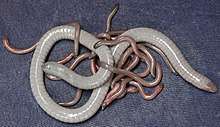Herpele
Herpele is a genus of caecilians in the family Herpelidae. They are endemic to Central and Western Africa (from southeastern Nigeria east to western Central African Republic and south to western Democratic Republic of the Congo, possibly to Angola).[1]
| Herpele | |
|---|---|
 | |
| Herpele squalostoma, female with her young | |
| Scientific classification | |
| Kingdom: | Animalia |
| Phylum: | Chordata |
| Class: | Amphibia |
| Order: | Gymnophiona |
| Clade: | Apoda |
| Family: | Herpelidae |
| Genus: | Herpele Peters, 1880 |
| Type species | |
| Caecilia squalostoma Stutchbury, 1834 | |
| Species | |
|
See text | |
At least Herpele squalostoma is probably oviparous and provides parental care: the young feed on their mother's skin (they are "dermatophagous").[2]
Species
There are two recognized species:[1]
| Binomial name and authority | Common name |
|---|---|
| Herpele multiplicata Nieden, 1912 | Victoria caecilian |
| Herpele squalostoma (Stutchbury, 1836) | Congo caecilian |
gollark: In CC, that is.
gollark: Plus, this way, my server/SPUDNET does 3% more work.
gollark: My management UI was *not* designed for this.
gollark: Observe, PCN 2.0.
gollark: APIONET you. By which I mean my ingame APIONET for opencomputers microcontrollers.
References
- Frost, Darrel R. (2013). "Herpele Peters, 1880". Amphibian Species of the World 5.6, an Online Reference. American Museum of Natural History. Retrieved 13 January 2014.
- Kouete, M. T.; Wilkinson, M.; Gower, D. J. (2012). "First reproductive observations for Herpele Peters, 1880 (Amphibia: Gymnophiona: Herpelidae): evidence of extended parental care and maternal dermatophagy in H. squalostoma (Stutchbury, 1836)". ISRN Zoology. 2012: 269690. doi:10.5402/2012/269690.
This article is issued from Wikipedia. The text is licensed under Creative Commons - Attribution - Sharealike. Additional terms may apply for the media files.